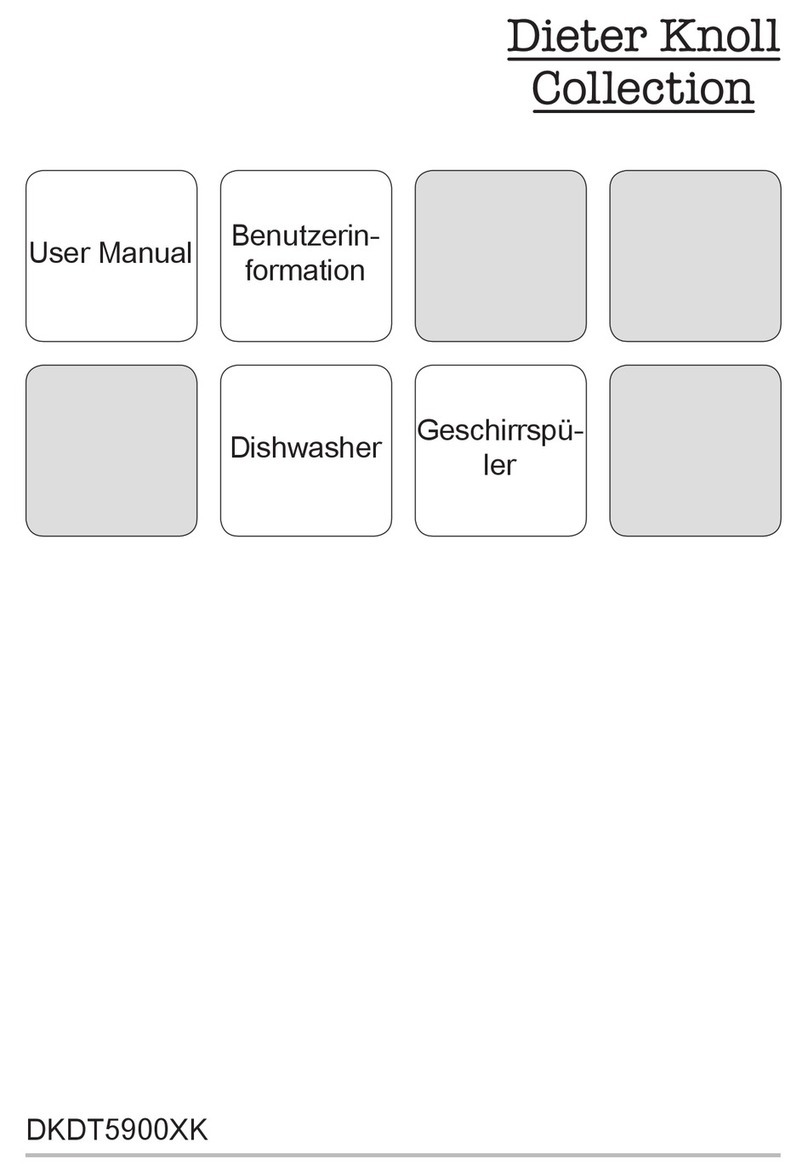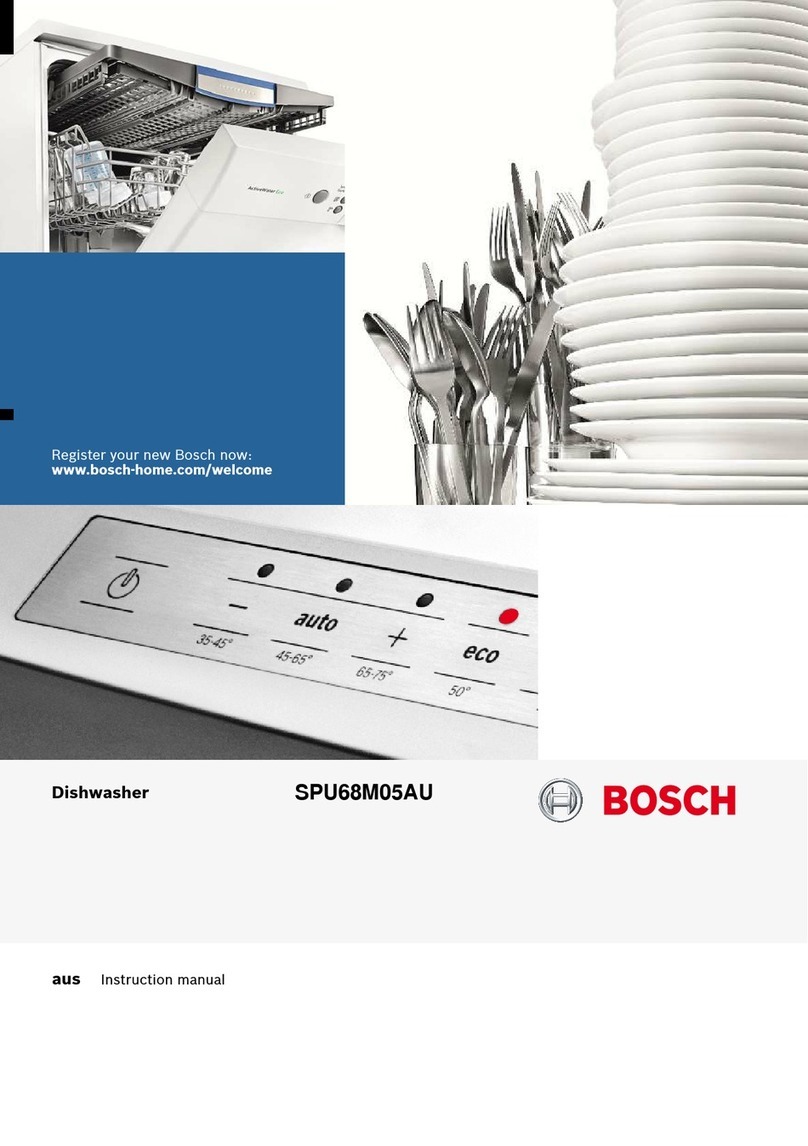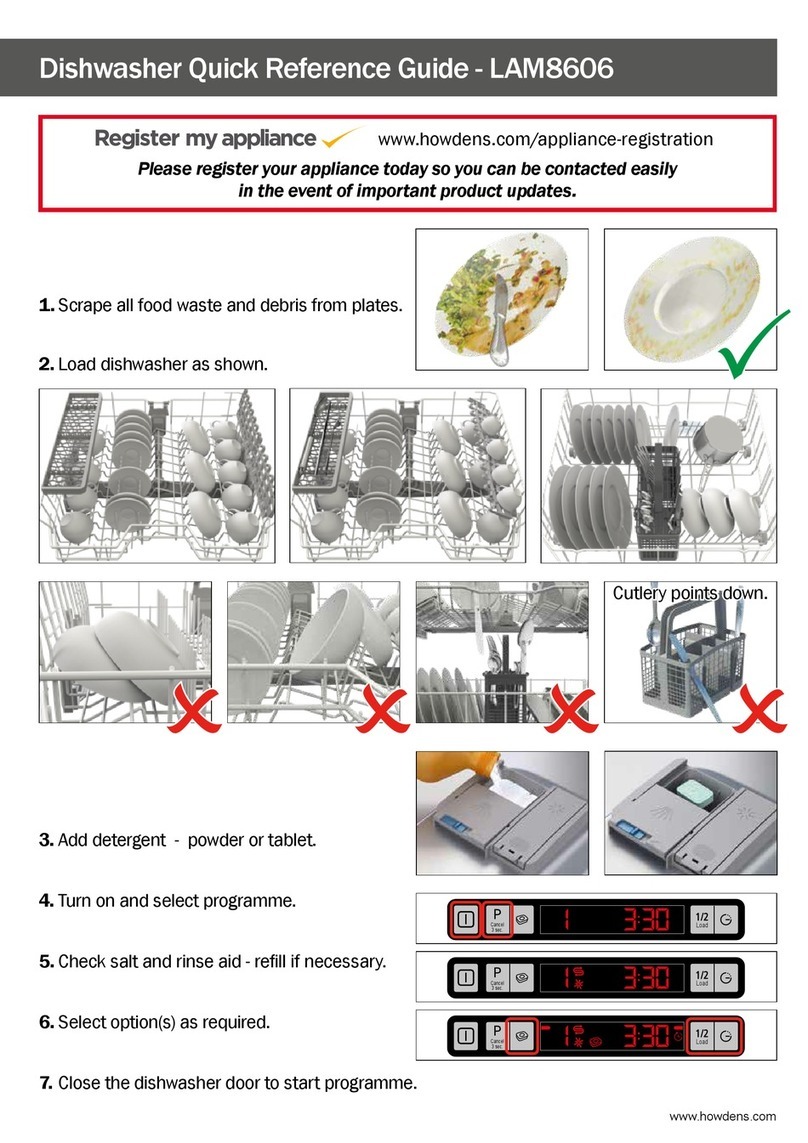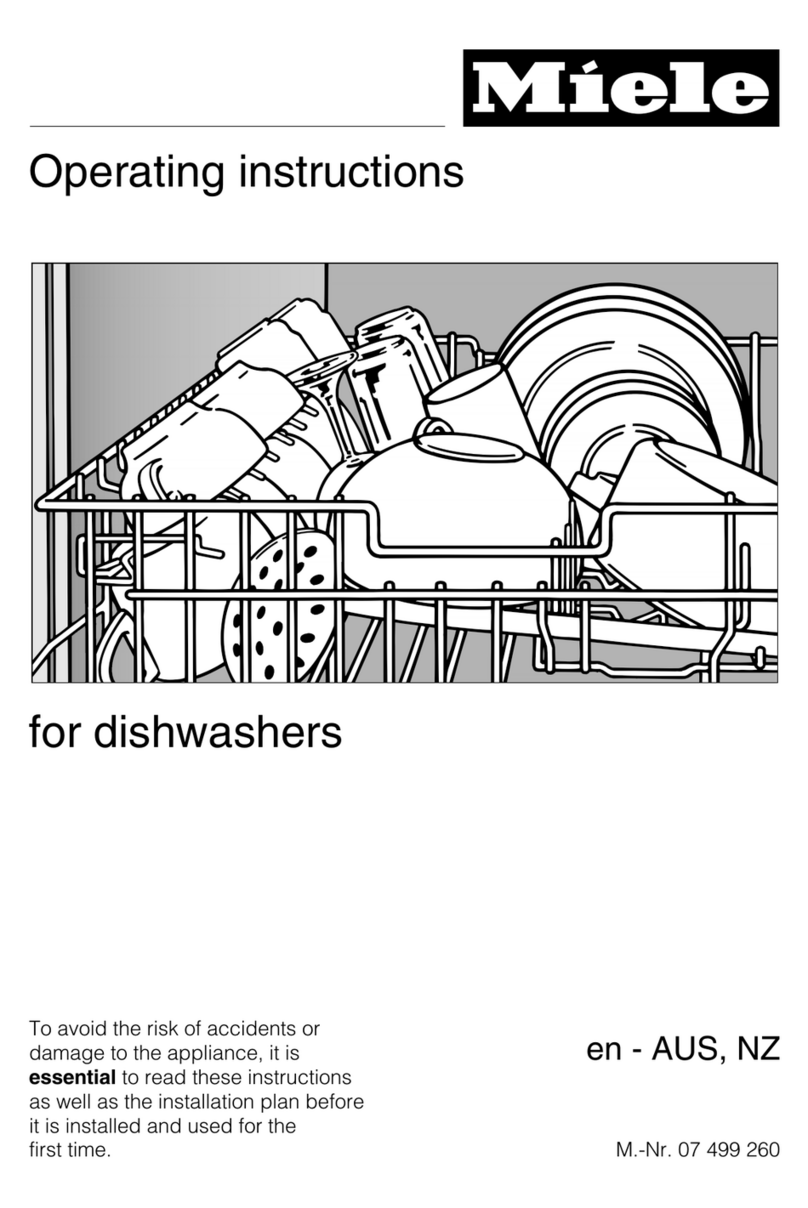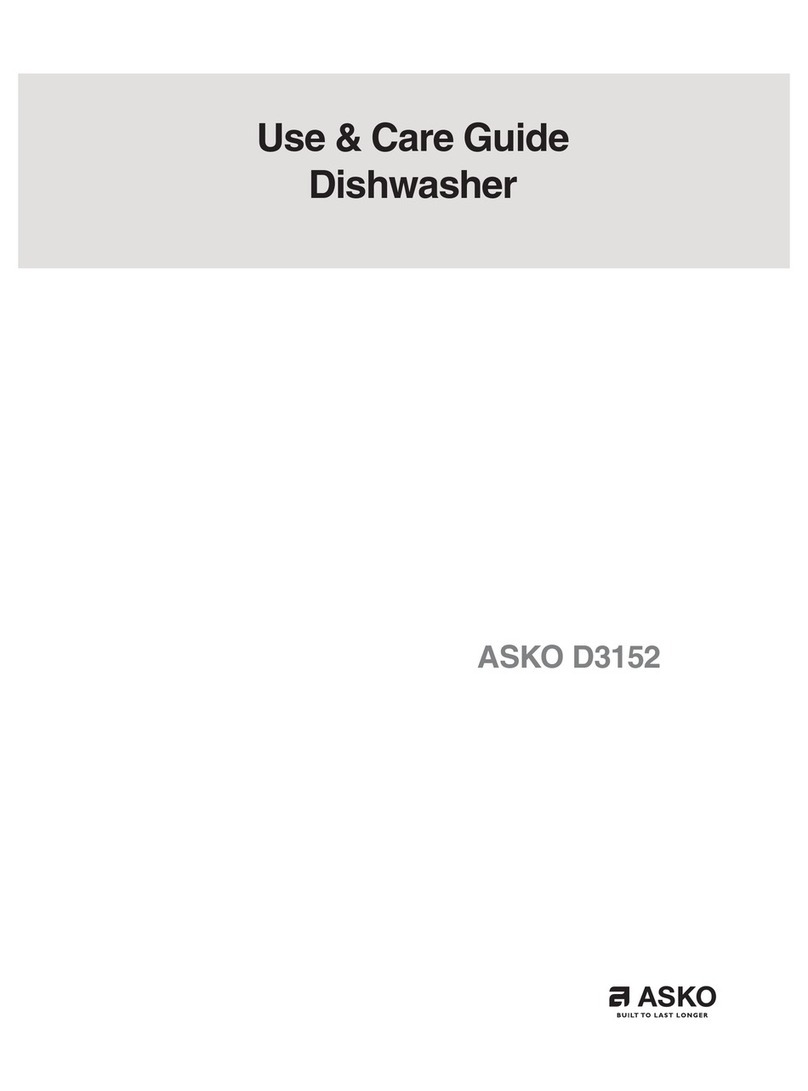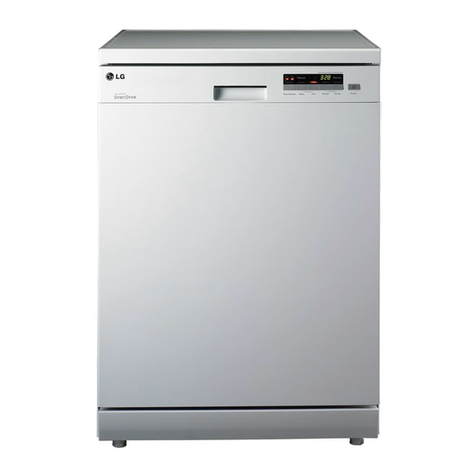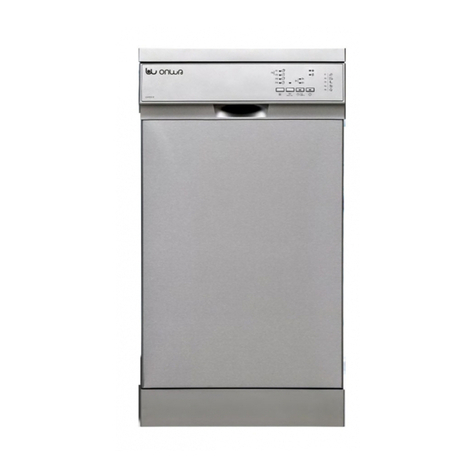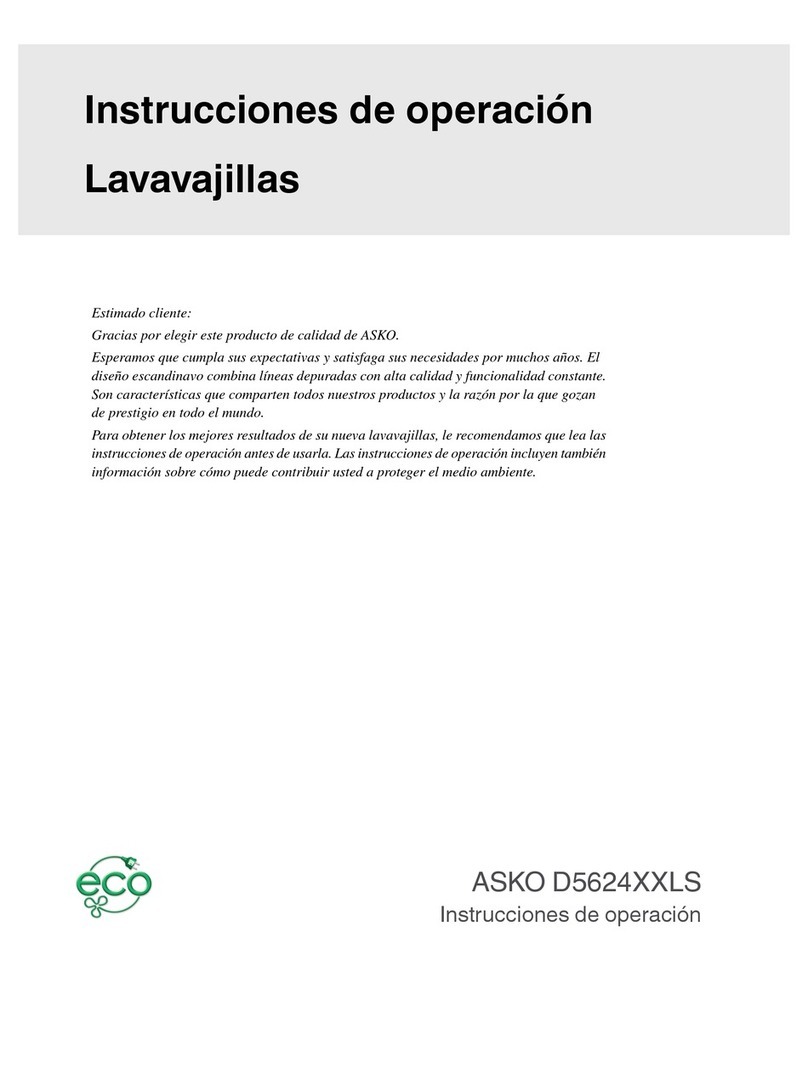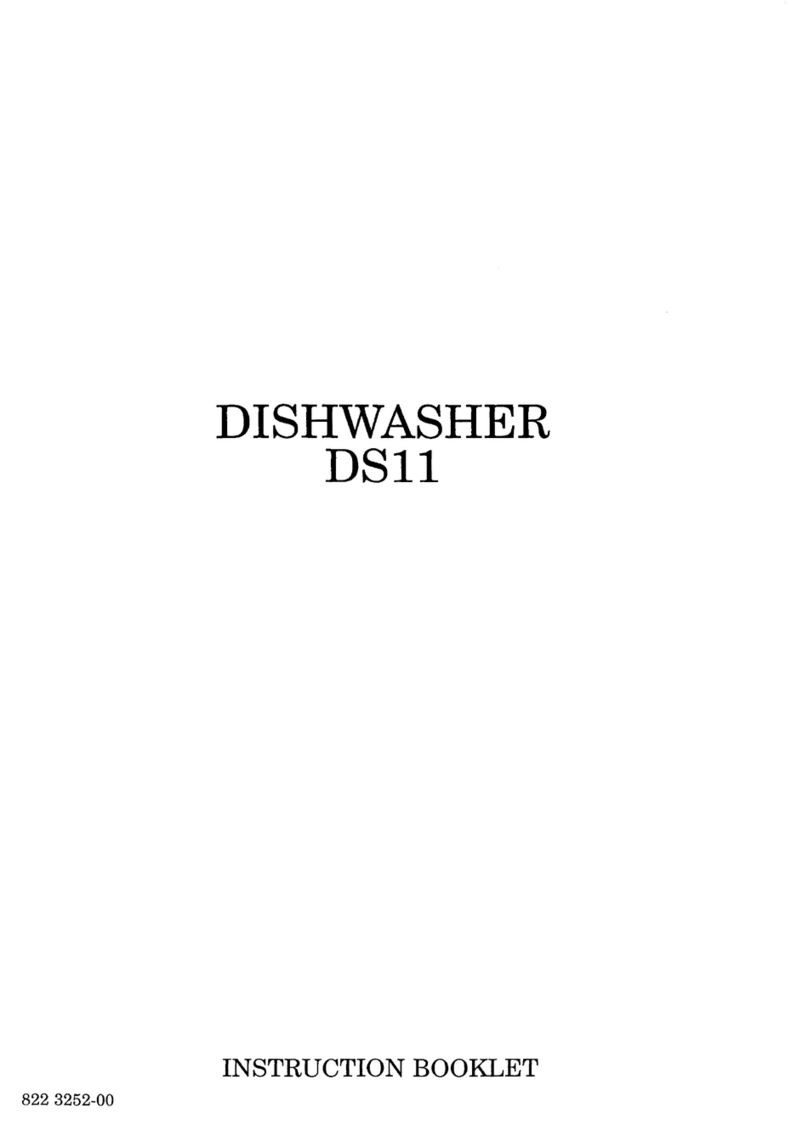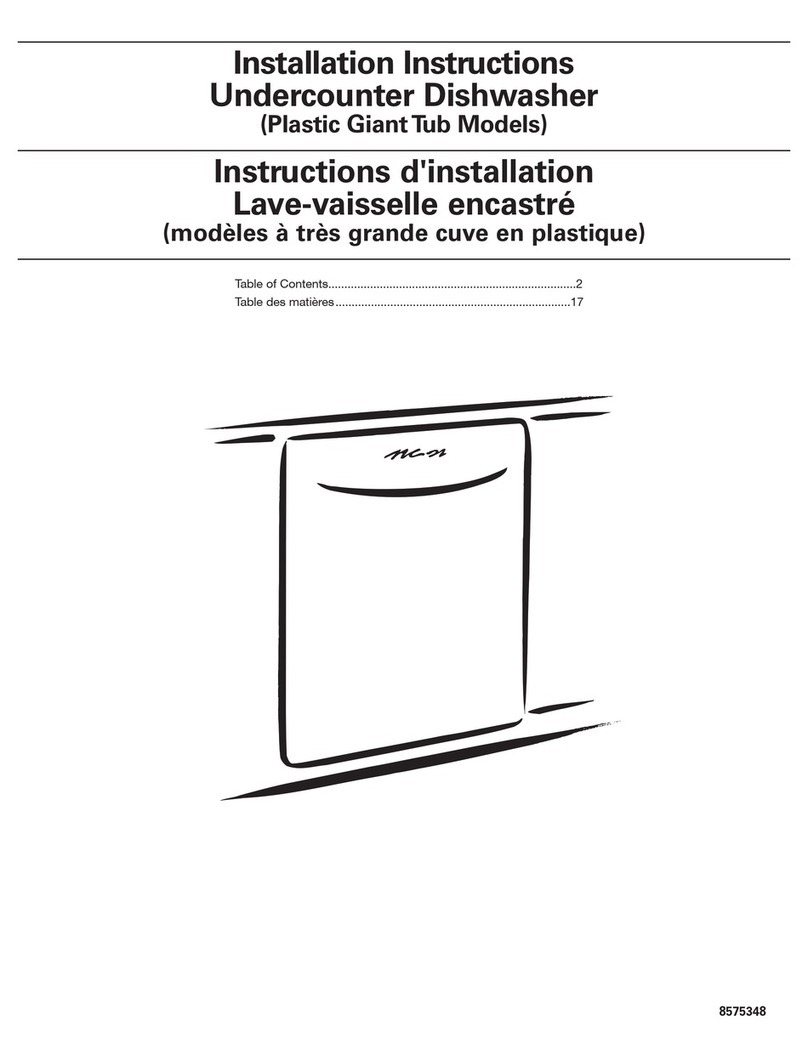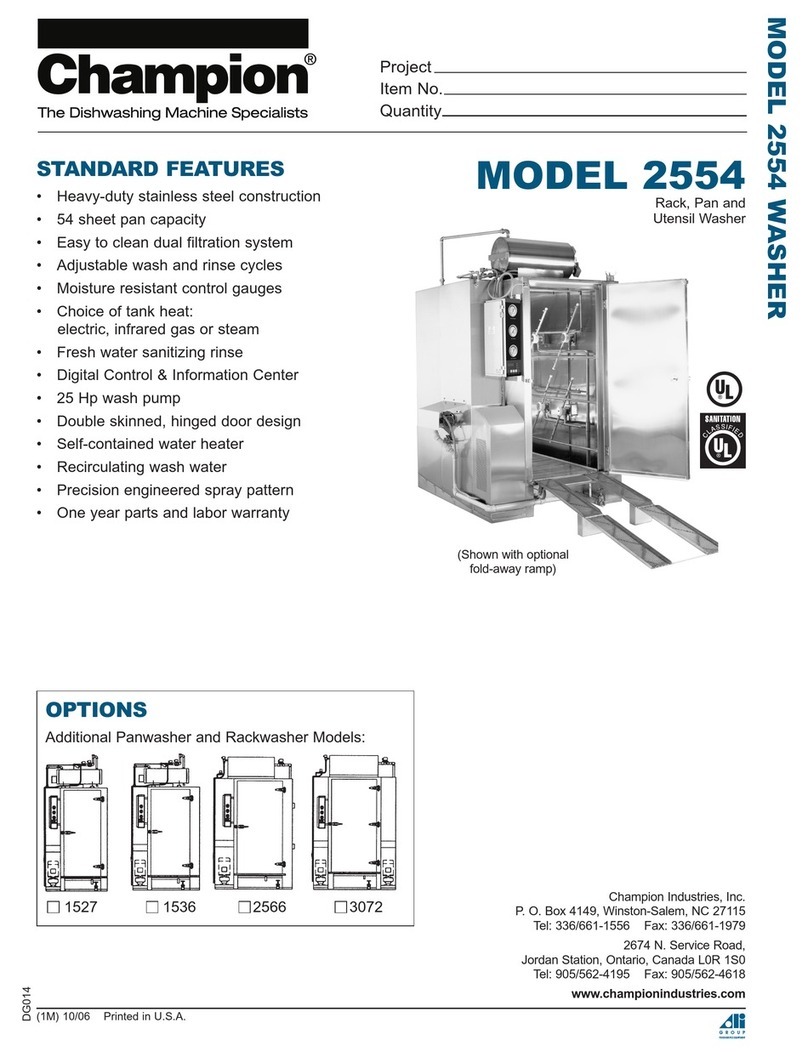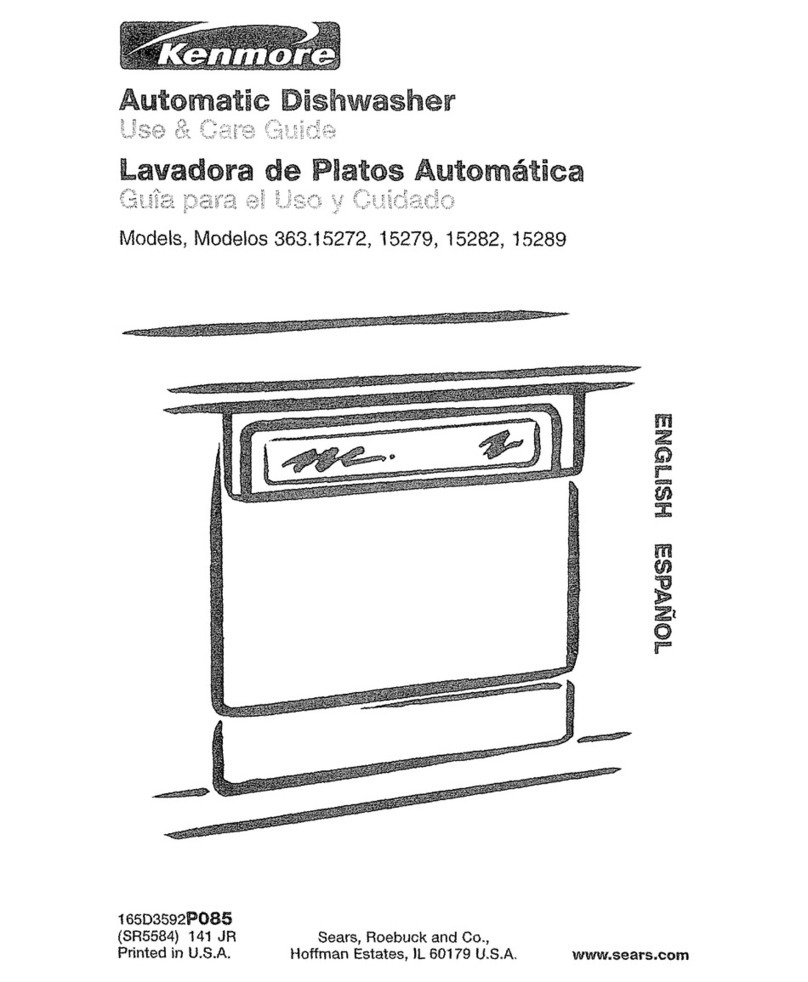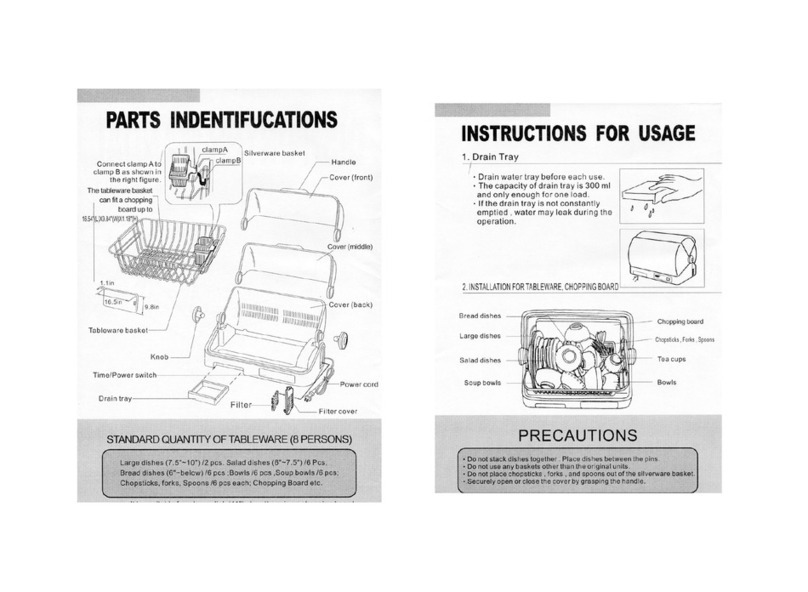Dieter Knoll Collection DKDT2651SK User manual

CONTENTS
1. SAFETY INFORMATION...................................................................................2
2. SAFETY INSTRUCTIONS.................................................................................4
3. PRODUCT DESCRIPTION............................................................................... 5
4. CONTROL PANEL............................................................................................ 7
5. PROGRAMME SELECTION............................................................................. 8
6. BASIC SETTINGS ..........................................................................................10
7. BEFORE FIRST USE...................................................................................... 14
8. DAILY USE......................................................................................................15
9. HINTS AND TIPS............................................................................................ 17
10. CARE AND CLEANING.................................................................................18
11. TROUBLESHOOTING...................................................................................21
12. TECHNICAL INFORMATION........................................................................ 25
13. ENVIRONMENTAL CONCERNS.................................................................. 26
Subject to change without notice.
1. SAFETY INFORMATION
Before the installation and use of the appliance, carefully read
the supplied instructions. The manufacturer is not responsible
for any injuries or damage that are the result of incorrect
installation or usage. Always keep the instructions in a safe
and accessible location for future reference.
1.1 Children and vulnerable people safety
•This appliance can be used by children aged from 8 years
and above and persons with reduced physical, sensory or
mental capabilities or lack of experience and knowledge if
they have been given supervision or instruction concerning
the use of the appliance in a safe way and understand the
hazards involved.
•Children between 3 and 8 years of age and persons with
very extensive and complex disabilities shall be kept away
from the appliance unless continuously supervised.
•Children of less than 3 years of age should be kept away
from the appliance unless continuously supervised.
•Do not let children play with the appliance.
•Keep detergents away from children.
2 ENGLISH

•Keep children and pets away from the appliance when the
door is open.
•Children shall not carry out cleaning and user maintenance
of the appliance without supervision.
1.2 General Safety
•This appliance is intended to be used in household and
similar applications such as:
–farm houses; staff kitchen areas in shops, offices and
other working environments;
–by clients in hotels, motels, bed & breakfast and other
residential type environments.
•Do not change the specification of this appliance.
•The operating water pressure (minimum and maximum)
must be between 0.5 (0.05) / 8 (0.8) bar (MPa)
•Follow the maximum number of 13 place settings.
•If the supply cord is damaged, it must be replaced by the
manufacturer, its Authorised Service Centre or similarly
qualified persons in order to avoid a hazard.
•Put the cutlery in the cutlery basket with the sharp ends
pointing down or put them in the cutlery drawer in a
horizontal position with the sharp edges down.
•Do not leave the appliance with the open door unattended
to avoid stepping accidentally onto it.
•Before any maintenance operation, deactivate the
appliance and disconnect the mains plug from the socket.
•Do not use high pressure water sprays and/or steam to
clean the appliance.
•If the appliance has ventilation openings in the base, they
must not be covered e.g. by a carpet.
•The appliance is to be connected to the water mains using
the new supplied hose-sets. Old hose sets must not be
reused.
ENGLISH 3

2. SAFETY INSTRUCTIONS
2.1 Installation
WARNING!
Only a qualified person must install this
appliance.
• Remove all the packaging.
• Do not install or use a damaged
appliance.
• Do not use the appliance before installing
it in the built-in structure due to safety
manner.
• Follow the installation instructions supplied
with the appliance.
• Always take care when moving the
appliance as it is heavy. Always use safety
gloves and enclosed footwear.
• Do not install or use the appliance where
the temperature is less than 0 °C.
• Install the appliance in a safe and suitable
place that meets installation requirements.
2.2 Electrical connection
WARNING!
Risk of fire and electric shock.
• The appliance must be earthed.
• Make sure that the parameters on the
rating plate are compatible with the
electrical ratings of the mains power
supply.
• Always use a correctly installed
shockproof socket.
• Do not use multi-plug adapters and
extension cables.
• Make sure not to cause damage to the
mains plug and to the mains cable. Should
the mains cable need to be replaced, this
must be carried out by our Authorised
Service Centre.
• Connect the mains plug to the mains
socket only at the end of the installation.
Make sure that there is access to the
mains plug after the installation.
• Do not pull the mains cable to disconnect
the appliance. Always pull the mains plug.
• This appliance is fitted with a 13 A mains
plug. If it is necessary to change the mains
plug fuse, use only a 13 A ASTA (BS
1362) fuse (UK and Ireland only).
2.3 Water connection
• Do not cause damage to the water hoses.
• Before connection to new pipes, pipes not
used for a long time, where repair work
has been carried out or new devices fitted
(water meters, etc.), let the water flow until
it is clean and clear.
• Ensure that there are no visible water
leaks during and after the first use of the
appliance.
• The water inlet hose has a safety valve
and a sheath with an inner mains cable.
WARNING!
Dangerous voltage.
• If the water inlet hose is damaged,
immediately close the water tap and
disconnect the mains plug from the mains
socket. Contact the Authorised Service
Centre to replace the water inlet hose.
2.4 Use
• Do not put flammable products or items
that are wet with flammable products in,
near or on the appliance.
• Dishwasher detergents are dangerous.
Follow the safety instructions on the
detergent packaging.
• Do not drink and play with the water in the
appliance.
• Do not remove the dishes from the
appliance until the programme is
complete. Some detergent may remain on
the dishes.
• Do not store items or apply pressure on
the open door of the appliance.
• The appliance can release hot steam if
you open the door while a programme
operates.
4 ENGLISH

2.5 Internal lighting
WARNING!
Risk of injury.
• Concerning the lamp(s) inside this product
and spare part lamps sold separately:
These lamps are intended to withstand
extreme physical conditions in household
appliances, such as temperature,
vibration, humidity, or are intended to
signal information about the operational
status of the appliance. They are not
intended to be used in other applications
and are not suitable for household room
illumination.
• To replace the internal lighting, contact the
Authorised Service Centre.
2.6 Service
• To repair the appliance contact the
Authorised Service Centre. Use original
spare parts only.
• Please note that self-repair or non-
professional repair can have safety
consequences and might void the
guarantee.
• The following spare parts will be available
for 7 years after the model has been
discontinued: motor, circulation and drain
pump, heaters and heating elements,
including heat pumps, piping and related
equipment including hoses, valves, filters
and aquastops, structural and interior
parts related to door assemblies, printed
circuit boards, electronic displays,
pressure switches, thermostats and
sensors, software and firmware including
reset software. Please note that some of
these spare parts are only available to
professional repairers, and that not all
spare parts are relevant for all models.
• The following spare parts will be available
for 10 years after the model has been
discontinued: door hinge and seals, other
seals, spray arms, drain filters, interior
racks and plastic peripherals such as
baskets and lids.
2.7 Disposal
WARNING!
Risk of injury or suffocation.
• Disconnect the appliance from the mains
supply.
• Cut off the mains cable and discard it.
• Remove the door catch to prevent children
and pets to get closed in the appliance.
3. PRODUCT DESCRIPTION
The graphics below is just a general
product overview. For more detailed
information, refer to other chapters
and/or documents provided with the
appliance.
ENGLISH 5

43
7
9 8
10 56
11
12
1Upper spray arm
2Lower spray arm
3Filters
4Rating plate
5Salt container
6Air vent
7Rinse aid dispenser
8Detergent dispenser
9Cutlery basket
10 Lower basket
11 Upper basket
3.1 Beam-on-Floor
The Beam-on-Floor is a light that is displayed
on the floor below the appliance door.
• When the programme starts, a red light
comes on and stays on for the duration of
the programme.
• When the programme is completed, a
green light comes on.
• When the appliance has a malfunction, the
red light flashes.
The Beam-on-Floor is off when the
appliance is deactivated.
When AirDry is activated during the
drying phase, the projection on the floor
may not be completely visible. To see if
the cycle has ended, check the control
panel.
6 ENGLISH

4. CONTROL PANEL
1 2 3 4 5 6
1On/Off button / Reset button
2Delay start button
3Display
4Programme buttons
5Extras buttons
6 programme button
4.1 Display
A AB
A. Indicators
B. Time indicator
4.2 Indicators
Indicator Description
Rinse aid indicator. It is on when the rinse aid dispenser needs refilling. Refer to "Before
first use".
Salt indicator. It is on when the salt container needs refilling. Refer to "Before first
use".
Machine Care indicator. It is on when the appliance needs internal cleaning with the Ma‐
chine Care programme. Refer to "Care and cleaning".
Drying phase indicator. It is on when a programme with the drying phase is selected. It
flashes when the drying phase operates. Refer to "Programme selection".
ENGLISH 7

5. PROGRAMME SELECTION
5.1 Programmes
A B C D E
A. • is the shortest programme
suitable for washing a load with fresh
and light soil.
• is a programme for rinsing off food
remains from the dishes. It prevents
odours forming in the appliance. Do
not use detergent with this
programme.
B. is a programme suitable for
washing a load with fresh and lightly
dried-on soil.
C. is a programme suitable for washing
and drying normally soiled items.
D. is a programme suitable for washing
and drying heavily soiled items.
E. is the longest programme offering
the most efficient use of energy and water
consumption for crockery and cutlery with
normal soil. This is the standard
programme for test institutes. 1)
5.2 Extras
You can adjust the programme selection to
your needs by activating Extras.
This option improves the washing results of
the selected programme. It increases the
wash temperature and duration.
This option provides special care for a
delicate load. It prevents rapid changes in the
wash temperature of the selected programme
and reduces it to 45 °C. This protects
glassware in particular from damaging.
5.3
This program automatically adjusts the wash
cycle to the type of load.
The appliance senses the degree of soil and
the amount of dishes in the baskets. It adjusts
the temperature and quantity of water as well
as the wash duration.
5.4 Programmes overview
Pro‐
gramme
Type of load Degree of
soil
Programme phases Options
• Crockery
• Cutlery
• Fresh • Wash 50 °C
• Intermediate rinse
• Final rinse 45 °C
• AirDry
•
•
• All types
of loads
• All de‐
grees of
soil
• Prewash Options are not appli‐
cable to this pro‐
gramme.
1) This programme is used to assess compliance with the Ecodesign Comission Regulation (EU) 2019/2022.
8 ENGLISH

Pro‐
gramme
Type of load Degree of
soil
Programme phases Options
• Crockery
• Cutlery
• Fresh
• Lightly
dried-on
• Wash 60 °C
• Intermediate rinse
• Final rinse 50 °C
• AirDry
•
•
• Crockery
• Cutlery
• Pots
• Pans
• Normal
• Lightly
dried-on
• Wash 60 °C
• Intermediate rinse
• Final rinse 55 °C
• Drying
• AirDry
•
•
• Crockery
• Cutlery
• Pots
• Pans
• Normal to
heavy
• Dried-on
• Prewash
• Wash 60 °C
• Intermediate rinse
• Final rinse 60 °C
• Drying
• AirDry
•
•
• Crockery
• Cutlery
• Pots
• Pans
• Normal
• Lightly
dried-on
• Prewash
• Wash 50 °C
• Intermediate rinse
• Final rinse 60 °C
• Drying
• AirDry
•
•
• Crockery
• Cutlery
• Pots
• Pans
The pro‐
gramme ad‐
justs to all de‐
grees of soil.
• Prewash
• Wash 50 - 60 °C
• Intermediate rinse
• Final rinse 55 °C
• Drying
• AirDry
Options are not appli‐
cable to this pro‐
gramme.
Machine
Care
• No load The pro‐
gramme cleans
the appliance
interior.
Refer to
"Care and
cleaning".
• Wash 65 °C
• Intermediate rinse
• Final rinse
• AirDry
Options are not appli‐
cable to this pro‐
gramme.
Consumption values
Programme 1) Water (l) Energy (kWh) Duration (min)
9.4 -11.4 0.57 - 0.69 30
3.7 - 4.5 0.02 - 0.05 15
ENGLISH 9

Programme 1) Water (l) Energy (kWh) Duration (min)
9.3 - 11.4 0.82 - 0.94 60
9.1 - 11.1 1.01 - 1.13 90
9.2 - 11.2 0.96 - 1.08 160
9.9 0.921 2) / 0.936 3) 240 2) / 240 3)
8.2 - 11.2 0.67 - 1.08 120 - 170
Machine Care 8.4 - 10.2 0.60 - 0.71 60
1) The pressure and the temperature of the water, the variations of the mains supply, the options and the quantity
of dishes can change the values.
2) In accordance with the 1016/2010 regulation
3) In accordance with the 2019/2022 regulation
Information for test institutes
To receive the necessary information for
conducting performance tests (e.g. according
to EN60436), send an email to:
In your request please include the product
number code (PNC) found on the rating plate.
For any other questions regarding your
dishwasher please refer to the service book
provided with your appliance.
6. BASIC SETTINGS
You can configure the appliance by changing
basic settings according to your needs.
Num‐
ber
Settings Values Description1)
1Water hardness From level 1L to
level 10L
Adjust the level of the water softener according to
the water hardness in your area.
Factory setting: 5L.
2Rinse aid empty
notification
1d (on)
0d (off)
Activate or deactivate the rinse aid indicator.
Factory setting: 1d.
3End sound 1b (on)
0b (off)
Activate or deactivate the acoustic signal for the
end of a programme.
Factory setting: 0b.
4Auto door open 1o (on)
0o (off)
Activate or deactivate the AirDry.
Factory setting: 1o.
10 ENGLISH

Num‐
ber
Settings Values Description1)
5Key tones 1F (on)
0F (off)
Activate or deactivate the sound of the buttons
when pressed.
Factory setting: 1F.
6Latest pro‐
gramme selection
1H (on)
0H (off)
Enable or disable the automatic selection of the
most recently used programme and options.
Factory setting: 0H.
1) For more details, refer to the information provided in this chapter.
You can change the basic settings in setting
mode. Instructions on how to configure the
appliance are provided further in this chapter.
When the appliance is in setting mode, the
display shows a digit and a letter. For each
setting, a dedicated letter is displayed. The
dedicated letters are indicated in the table.
The order of the basic settings presented in
the table is also the order of the settings in
setting mode.
6.1 The water softener
The water softener removes minerals from
the water supply, which would have a
negative effect on the washing results and on
the appliance.
The higher the content of these minerals, the
harder your water is. Water hardness is
measured in equivalent scales.
The water softener should be adjusted
according to the hardness of the water in your
area. Your local water authority can advise
you on the hardness of the water in your
area. It is important to set the right level of the
water softener to assure good washing
results.
Water hardness
German de‐
grees (°dH)
French de‐
grees (°fH)
mmol/l Clarke de‐
grees
Water softener
level
47 - 50 84 - 90 8.4 - 9.0 58 - 63 10
43 - 46 76 - 83 7.6 - 8.3 53 - 57 9
37 - 42 65 - 75 6.5 - 7.5 46 - 52 8
29 - 36 51 - 64 5.1 - 6.4 36 - 45 7
23 - 28 40 - 50 4.0 - 5.0 28 - 35 6
19 - 22 33 - 39 3.3 - 3.9 23 - 27 5 1)
15 - 18 26 - 32 2.6 - 3.2 18 - 22 4
11 - 14 19 - 25 1.9 - 2.5 13 - 17 3
4 - 10 7 - 18 0.7 - 1.8 5 - 12 2
<4 <7 <0.7 < 5 1 2)
1) Factory setting.
2) Do not use salt at this level.
ENGLISH 11

Regardless of the type of detergent used,
set the proper water hardness level to
keep the salt refill indicator active.
Multi-tabs containing salt are not
effective enough to soften hard water.
Regeneration process
For the correct water softener operation, the
resin of the softener device needs to be
regenerated regularly. This process is
automatic and is the part of the normal
dishwasher operation.
When the prescribed quantity of water (see
values in the table) has been used since the
previous regeneration process, a new
regeneration process will be initiated between
the final rinse and the programme end.
Water softener lev‐
el
Amount of water
(l)
1 250
2 100
3 62
4 47
5 25
6 17
7 10
8 5
9 3
10 3
In case of the high water softener setting, it
may occur also in the middle of the
programme, before the rinse (twice during a
programme). Regeneration initiation has no
impact on the cycle duration, unless it occurs
in the middle of a programme or at the end of
a programme with a short drying phase. In
that cases, the regeneration prolongs the
total duration of a programme by additional 5
minutes.
Subsequently, the rinsing of the water
softener that lasts 5 minutes may begin in the
same cycle or at the beginning of the next
programme. This activity increases the total
water consumption of a programme by
additional 4 litres and the total energy
consumption of a programme by additional 2
Wh. The rinsing of the softener ends with a
complete drain.
Each performed softener rinse (possible more
than one in the same cycle) may prolong the
programme duration by another 5 minutes
when it occurs at any point at the beginning
or in the middle of a programme.
All the consumption values
mentioned in this section are determined
in accordance with the currently
applicable standard in laboratory
conditions with water hardness
2.5mmol/L according to the 2019/2022
regulation (water softener: level 3).
The pressure and the temperature of
water as well as the variations of the
mains supply can change the values.
6.2 The rinse aid empty notification
The rinse aid helps to dry the dishes without
streaks and stains. It is automatically
released during the hot rinse phase.
When the rinse aid chamber is empty, the
rinse aid indicator is turned on notifying to
refill rinse aid. If the drying results are
satisfactory while using multi-tablets only, it is
possible to deactivate the notification for
refilling rinse aid. However, for best drying
performance, always use rinse aid.
If standard detergent or multi-tablets without
rinse aid are used, activate the notification to
keep the rinse aid refill indicator active.
6.3 End sound
You can activate an acoustic signal that
sounds when the programme is completed.
Acoustic signals sound also when a
malfunction of the appliance occurs. It is
not possible to deactivate these signals.
6.4 AirDry
AirDry improves the drying results. The
appliance door opens automatically during
the drying phase and remains ajar.
12 ENGLISH

AirDry is automatically activated with all
programmes other than .
CAUTION!
Do not try to close the appliance door
within 2 minutes after automatic opening.
This can cause damage to the appliance.
CAUTION!
If children have access to the appliance,
we advise to deactivate AirDry. The
automatic opening of the door may pose
a danger.
When AirDry opens the door, Beam-
on-Floor might not be completely visible.
To see if the programme is complete,
look at the control panel.
6.5 Key tones
The buttons on the control panel make a click
sound when you press them. You can
deactivate this sound.
6.6 Latest programme selection
You can set the automatic selection of the
most recently used programme and options.
The latest programme that was completed
before the appliance deactivation is saved. It
is then selected automatically after you
activate the appliance.
When the latest programme selection is
disabled, the default programme is .
6.7 Setting mode
How to navigate in setting mode
You can navigate in setting mode using
programme buttons.
A B C
A. Previous button
B. OK button
C. Next button
Use Previous and Next to switch between
the basic settings and to change their value.
Use OK to enter the selected setting and to
confirm changing its value.
How to enter setting mode
You can enter setting mode before starting a
programme. You cannot enter setting mode
while the programme is running.
To enter setting mode, press and hold
simultaneously and for about 3
seconds.
The lights related to the Previous, OK and
Next are on.
How to change a setting
Make sure the appliance is in setting mode.
1. Use Previous or Next to select the
desired setting.
The display shows the current setting value
(a digit and the dedicated letter).
2. Press OK to enter the setting.
The current setting value flashes.
3. Press Previous or Next to change the
value.
4. Press OK to confirm the setting.
• The new setting is saved.
• The appliance returns to the basic
settings list.
ENGLISH 13

5. Press and hold simultaneously and
for about 3 seconds to exit setting
mode.
The appliance returns to the programme
selection.
The saved settings remain valid until you
change them again.
7. BEFORE FIRST USE
1. Make sure that the current level of the
water softener agrees with the
hardness of the water supply. If not,
adjust the level of the water softener.
2. Fill the salt container.
3. Fill the rinse aid dispenser.
4. Open the water tap.
5. Start the programme to remove any
residuals from the manufacturing
process. Do not use detergent and do not
put dishes in the baskets.
After starting the programme, the appliance
recharges the resin in the water softener for
up to 5 minutes. The washing phase starts
only after this procedure is complete. The
procedure is repeated periodically.
7.1 The salt container
CAUTION!
Use rough salt designed for dishwashers
only. Fine salt increases the risk of
corrosion.
The salt is used to recharge the resin in the
water softener and to assure good washing
results in daily use.
How to fill the salt container
1. Turn the cap of the salt container
counterclockwise and remove it.
2. Put 1 litre of water in the salt container
(only for the first time).
3. Fill the salt container with 1 kg of salt
(until it is full).
4. Carefully shake the funnel by its handle to
get the last granules inside.
5. Remove the salt around the opening of
the salt container.
6. Turn the cap of the salt container
clockwise to close the salt container.
CAUTION!
Water and salt can come out of the salt
container when you fill it. After you fill the
salt container, immediately start a
programme to prevent corrosion.
14 ENGLISH

7.2 How to fill the rinse aid dispenser
M
A
X
1
2
3
4
+
-
A B
D
C
CAUTION!
Only use rinse aid designed specifically
for dishwashers.
1. Press the release button (D) to open the
lid (C).
2. Pour the rinse aid in the dispenser (A)
until the liquid reaches the fill level 'max'.
3. Remove the spilled rinse aid with an
absorbent cloth to prevent excessive
foam formation.
4. Close the lid. Make sure that the release
button locks into position.
You can turn the selector of the
released quantity (B) between position 1
(lowest quantity) and position 4 or 6
(highest quantity).
8. DAILY USE
1. Open the water tap.
2. Press and hold until the appliance is
activated.
3. Fill the salt container if it is empty.
4. Fill the rinse aid dispenser if it is empty.
5. Load the baskets.
6. Add the detergent.
7. Select and start a programme.
8. Close the water tap when the programme
is complete.
8.1 Using the detergent
B
C
A
1. Press the release button (B) to open the
lid (C).
2. Put the detergent, in powder or tablets, in
the compartment (A).
3. If the programme has a prewash phase,
put a small quantity of detergent on the
inner part of the appliance door.
4. Close the lid. Make sure that the release
button locks into position.
8.2 How to select and start a
programme
1. Press the button dedicated to the
programme you want to set.
• The light related to the button is on.
• The display shows the programme
duration.
2. Activate applicable options if desired.
3. Close the appliance door to start the
programme.
8.3 How to select and start the
programme
1. To select , press and hold for 3
seconds.
• The light related to the button is on.
• The display shows the programme
duration.
2. Close the appliance door to start the
programme.
ENGLISH 15

8.4 How to activate Extras
1. Select a programme.
2. Press the button dedicated to the option
you want to activate.
• The light related to the button is on.
• The display shows the updated
programme duration.
By default, options must be activated
every time before you start a programme.
If the latest programme selection is
enabled, the saved options are activated
automatically along with the programme.
It is not possible to activate or
deactivate options while a programme is
running.
Not all options are compatible with
each other.
Activating options often increases the
water and energy consumption as well as
the programme duration.
8.5 How to select and start the
programme
1. Press .
• The light related to the button is on.
• The display shows the programme
duration.
Options are not applicable to this
programme.
2. Close the appliance door to start the
programme.
The appliance senses the type of load and
adjusts a suitable wash cycle. During the
cycle, the sensors operate several times and
the initial programme duration can decrease.
8.6 How to delay the start of a
programme
1. Select a programme.
2. Press repeatedly until the display
shows the desired delay time (from 1 to
24 hours).
The light related to the button is on.
3. Close the appliance door to start the
countdown.
During the countdown, it is not possible to
change the delay time and the programme
selection.
When the countdown is complete, the
programme starts.
8.7 How to cancel the delay start while
the countdown operates
Press and hold for about 3 seconds.
The appliance returns to the programme
selection.
If you cancel the delay start, you have
to select the programme again.
8.8 How to cancel a running
programme
Press and hold for about 3 seconds.
The appliance returns to the programme
selection.
Make sure that there is detergent in
the detergent dispenser before you start
a new programme.
8.9 Opening the door while the
appliance operates
Opening the door while a programme is
running stops the appliance. It may affect the
energy consumption and the programme
duration. After closing the door, the appliance
continues from the point of interruption.
If the door is opened for more than 30
seconds during the drying phase, the
running programme ends. It does not
happen if the door is opened by AirDry
function.
16 ENGLISH

8.10 The Auto Off function
This function saves energy by switching the
appliance off when it is not operating.
The function comes into operation
automatically:
• When the programme is completed.
• After 5 minutes if a programme was not
started.
8.11 End of the programme
When the programme is complete, the
display shows 0:00.
The Auto Off function switches the appliance
off automatically.
All buttons are inactive except for the on/off
button.
9. HINTS AND TIPS
9.1 General
Follow the hints below to ensure optimal
cleaning and drying results in daily use and to
protect the environment.
• Washing dishes in the dishwasher as
instructed in the user manual usually
consumes less water and energy than
washing dishes by hand.
• Load the dishwasher to its full capacity to
save water and energy. For best cleaning
results, arrange items in the baskets as
instructed in the user manual and do not
overload the baskets.
• Do not pre-rinse dishes by hand. It
increases the water and energy
consumption. When needed, select a
programme with a prewash phase.
• Remove larger residues of food from the
dishes and empty cups and glasses
before putting them inside the appliance.
• Soak or slightly scour cookware with firmly
cooked-on or baked-on food before
washing it in the appliance.
• Make sure that items in the baskets do not
touch or cover each other. Only then can
the water completely reach and wash the
dishes.
• You can use dishwasher detergent, rinse
aid and salt separately or you can use the
multi-tablets (e.g. ''All in 1''). Follow the
instructions on the packaging.
• Select a programme according to the type
of load and the degree of soil.
offers the most efficient use of water and
energy consumption.
• To prevent limescale buildup inside the
appliance:
– Refill the salt container whenever
necessary.
– Use the recommended dosage of the
detergent and rinse aid.
– Make sure that the current level of the
water softener agrees with the
hardness of the water supply.
– Follow the instructions in the chapter
"Care and cleaning".
9.2 Using salt, rinse aid and detergent
• Only use salt, rinse aid and detergent
designed for dishwasher. Other products
can cause damage to the appliance.
• In areas with hard and very hard water, we
recommend to use basic dishwasher
detergent (powder, gel, tablets containing
no additional agents), rinse aid and salt
separately for optimal cleaning and drying
results.
• Detergent tablets do not fully dissolve with
short programmes. To prevent detergent
residues on the tableware, we recommend
that you use tablets with long
programmes.
• Always use the correct quantity of
detergent. Insufficient dosage of detergent
can result in poor cleaning results and
hard-water filming or spotting on the items.
Using too much detergent with soft or
softened water results in detergent
residues on the dishes. Adjust the amount
of detergent based on the water hardness.
Refer to the instructions on the detergent
packaging.
• Always use the correct quantity of rinse
aid. Insufficient dosage of rinse aid
decreases the drying results. Using too
much rinse aid results in bluish layers on
the items.
• Make sure that the water softener level is
correct. If the level is too high, the
ENGLISH 17

increased quantity of salt in the water
might result in rust on cutlery.
9.3 What to do if you want to stop
using multi-tablets
Before you start using separately detergent,
salt and rinse aid, complete the following
steps:
1. Set the highest level of the water
softener.
2. Make sure that the salt and rinse aid
containers are full.
3. Start the programme. Do not add
detergent and do not put dishes in the
baskets.
4. When the programme is completed,
adjust the water softener according to the
water hardness in your area.
5. Adjust the released quantity of rinse aid.
9.4 Before starting a programme
Before you start the selected programme,
make sure that:
• The filters are clean and correctly
installed.
• The cap of the salt container is tight.
• The spray arms are not clogged.
• There is enough salt and rinse aid (unless
you use multi-tablets).
• The arrangement of the items in the
baskets is correct.
• The programme is suitable to the type of
load and the degree of soil.
• The correct quantity of detergent is used.
9.5 Loading the baskets
• Always use the whole space of the
baskets.
• Use the appliance to wash dishwasher-
safe items only.
• Do not wash in the appliance items made
of wood, horn, aluminium, pewter and
copper as they could crack, warp, get
discoloured or pitted.
• Do not wash in the appliance items that
can absorb water (sponges, household
cloths).
• Put hollow items (cups, glasses and pans)
with the opening facing downwards.
• Make sure that glasses do not touch each
other.
• Put light items in the upper basket. Make
sure that the items do not move freely.
• Put cutlery and small items in the cutlery
basket.
• Make sure that the spray arms can move
freely before you start a programme.
9.6 Unloading the baskets
1. Let the tableware cool down before you
remove it from the appliance. Hot items
can be easily damaged.
2. First remove items from the lower basket,
then from the upper basket.
After the programme is completed,
water can still remain on the inside
surfaces of the appliance.
10. CARE AND CLEANING
WARNING!
Before any maintenance other than
running the programme Machine Care,
deactivate the appliance and disconnect
the mains plug from the main socket.
Dirty filters and clogged spray arms
negatively affect the washing results.
Check these elements regularly and, if
necessary, clean them.
10.1 Machine Care
Machine Care is a programme designed to
clean the appliance interior with optimal
results. It removes limescale and grease
buildup.
When the appliance senses the need for
cleaning, the indicator is on. Start the
Machine Care programme to clean the
appliance interior.
18 ENGLISH

How to start the Machine Care
programme
Before starting the Machine Care
programme, clean the filters and spray
arms.
1. Use a descaler or a cleaning product
designed specifically for dishwashers.
Follow the instructions on the packaging.
Do not put dishes in the baskets.
2. Press and hold simultaneously and
for about 3 seconds.
The indicators and flash. The display
shows the programme duration.
3. Close the appliance door to start the
programme.
When the programme is complete, the
indicator is off.
10.2 Internal cleaning
• Carefully clean the appliance, including
the rubber gasket of the door, with a soft
damp cloth.
• Do not use abrasive products, abrasive
cleaning pads, sharp tools, strong
chemicals, scourer or solvents.
• To maintain the performance of your
appliance, use a cleaning product
designed specifically for dishwashers at
least once every two months. Carefully
follow the instructions on the packaging of
the product.
• For optimal cleaning results, start the
Machine Care programme.
10.3 Removal of foreign objects
Check the filters and the sump after each use
of the dishwasher. Foreign objects (e.g.
pieces of glass, plastic, bones or toothpicks,
etc) decrease the cleaning performance and
can cause damage to the drain pump.
1. Disassemble the filters system as
instructed in this chapter.
2. Remove any foreign objects by hand.
CAUTION!
If unable to remove the objects,
contact an Authorised Service
Centre.
3. Reassemble the filters as instructed in
this chapter.
10.4 External cleaning
• Clean the appliance with a moist soft
cloth.
• Only use neutral detergents.
• Do not use abrasive products, abrasive
cleaning pads or solvents.
10.5 Cleaning the filters
The filter system is made of 3 parts.
C
B
A
1. Turn the filter (B) counterclockwise and
remove it.
2. Remove the filter (C) out of filter (B).
ENGLISH 19

3. Remove the flat filter (A).
4. Wash the filters.
5. Make sure that there are no residues of
food or soil in or around the edge of the
sump.
6. Put back in place the flat filter (A). Make
sure that it is correctly positioned under
the 2 guides.
7. Reassemble the filters (B) and (C).
8. Put back the filter (B) in the flat filter (A).
Turn it clockwise until it locks.
CAUTION!
An incorrect position of the filters can
cause bad washing results and damage
to the appliance.
10.6 Cleaning the lower spray arm
We recommend to clean the lower spray arm
regularly to prevent soil from clogging the
holes.
Clogged holes can cause unsatisfactory
washing results.
1. To remove the lower spray arm, pull it
upwards.
2. Wash the spray arm under running water.
Use a thin pointed tool, e.g. a toothpick,
to remove particles of soil from the holes.
20 ENGLISH
Table of contents
Languages:
Other Dieter Knoll Collection Dishwasher manuals

